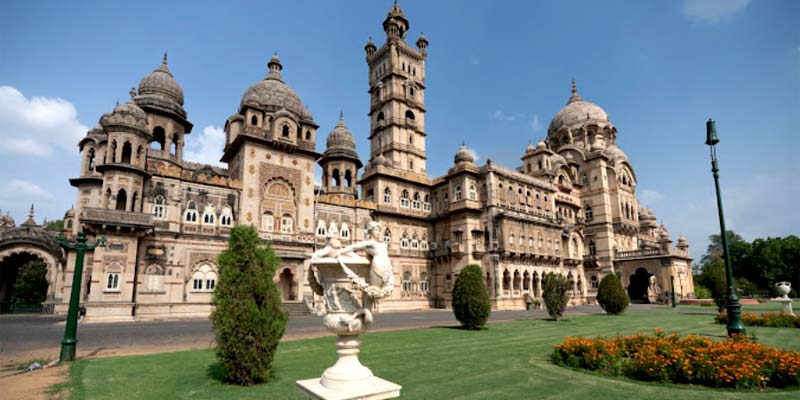Nestled in the heart of Vadodara, Gujarat, Laxmi Vilas Palace stands as a grand symbol of India’s regal past. This magnificent edifice is not just an architectural marvel but also a significant cultural and historical landmark. Constructed in the Indo-Saracenic style, the palace is an epitome of grandeur and opulence, reflecting the glory of the erstwhile princely state of Baroda. This article delves into the history, architecture, and cultural significance of Laxmi Vilas Palace, providing a comprehensive guide for history enthusiasts and travelers alike.
The History of Laxmi Vilas Palace
The Vision of Maharaja Sayajirao Gaekwad III
Maharaja Sayajirao Gaekwad III, a visionary ruler who played a crucial role in the development of Baroda, commissioned the Laxmi Vilas Palace. Construction began in 1878 and concluded in 1890. Major Charles Mant designed the palace to replace the older Makarpura Palace. Maharaja Sayajirao Gaekwad III wanted a residence that would reflect the grandeur and power of his reign, and Laxmi Vilas Palace was his answer to that aspiration.
The Symbol of Modernity and Progress
During the late 19th and early 20th centuries, Baroda was one of the most progressive princely states in India. Maharaja Sayajirao Gaekwad III was a reformist who introduced various modern amenities and reforms in his state. Laxmi Vilas Palace was not just a royal residence but also a symbol of the modern and progressive outlook of the Gaekwad dynasty. The palace was equipped with modern facilities such as elevators and electrical systems, which were rare during that era.
Architectural Marvel: A Blend of Cultures
Indo-Saracenic Style
Laxmi Vilas Palace is a splendid example of the Indo-Saracenic architectural style, which combines elements of Indian, Islamic, and European architecture. This eclectic style was popular during the British Raj and was used for many public buildings and palaces across India. The palace features ornate balconies, arched windows, and intricately carved pillars, all of which are hallmarks of this unique architectural style.
The Grand Facade
The palace’s grand facade is one of its most striking features. The extensive use of marble and mosaic, coupled with the beautifully landscaped gardens, creates a stunning visual impact. The central dome of the palace is particularly impressive, standing tall and majestic, symbolizing the power and grandeur of the Gaekwad dynasty.
Interiors: A Testament to Luxury
The interiors of Laxmi Vilas Palace are a testament to luxury and opulence. The palace boasts over 170 rooms, each adorned with exquisite furniture, paintings, and artifacts. The Darbar Hall, used for official functions and ceremonies, is one of the most magnificent rooms in the palace. It features Venetian chandeliers, intricate ceiling paintings, and a stunning collection of antique furniture.
Cultural Significance and Heritage
A Hub of Art and Culture
Laxmi Vilas Palace has always been a hub of art and culture. The Gaekwad rulers were great patrons of the arts, and their palace reflects this passion. The palace houses an impressive collection of artworks, including paintings by renowned artists such as Raja Ravi Varma. The extensive collection of artifacts and antiques provides a glimpse into the rich cultural heritage of the region.
The Museum and Its Treasures
The palace complex also includes the Maharaja Fateh Singh Museum, which was originally built as a school for the Maharaja’s children. Today, the museum showcases an extensive collection of art and artifacts from around the world. Visitors can admire the works of European and Indian artists, as well as a fascinating collection of sculptures, textiles, and weaponry.
A Venue for Cultural Events
Laxmi Vilas Palace continues to play a significant role in the cultural life of Vadodara. The palace grounds are often used for hosting cultural events, music concerts, and traditional festivals. These events not only celebrate the region’s rich cultural heritage but also attract tourists from all over the world, adding to the palace’s cultural significance.
Visiting Laxmi Vilas Palace: A Travel Guide
How to Reach Laxmi Vilas Palace
Laxmi Vilas Palace is located in the city of Vadodara, Gujarat, making it easily accessible by various modes of transportation. The city is well-connected by air, rail, and road.
- By Air: The nearest airport is Vadodara Airport, which is about 8 kilometers from the palace. Regular flights connect Vadodara to major cities like Mumbai, Delhi, and Bangalore.
- By Train: Vadodara Junction is a major railway station on the Western Railway network. It is well-connected to cities across India, including Mumbai, Delhi, Ahmedabad, and Jaipur.
- By Road: Vadodara is well-connected by road, and the palace is easily accessible from the city center. Taxis, auto-rickshaws, and local buses are available for convenient transportation.
Best Time to Visit
The best time to visit Laxmi Vilas Palace is during the winter months from October to March. The weather during this period is pleasant, making it ideal for exploring the palace and its surroundings. The palace is open to visitors from Tuesday to Sunday, with guided tours available to enhance the visitor experience.
Exploring the Palace Complex
Visitors to Laxmi Vilas Palace can explore the palace complex, which includes the main palace, the museum, and the beautifully landscaped gardens. The guided tours provide detailed information about the history and architecture of the palace, offering a deeper understanding of its significance.
Photography and Etiquette
You can take photographs in certain areas of the palace, but you must respect the rules and guidelines. Dress modestly and behave respectfully, as the palace is not just a tourist attraction but also a heritage site of great cultural importance.
The Legacy of Laxmi Vilas Palace
The Gaekwad Dynasty
The legacy of Laxmi Vilas Palace is closely tied to the Gaekwad dynasty. The Gaekwads had a progressive outlook and contributed significantly to the development of Baroda. The palace stands as a monument to their vision and achievements, reflecting the grandeur and sophistication of their rule.
Preservation and Restoration
Efforts have been made to preserve and restore Laxmi Vilas Palace, ensuring that its architectural and cultural heritage is maintained for future generations. The palace is a protected monument under the Archaeological Survey of India, and ongoing restoration work aims to preserve its intricate details and grandeur.
The Palace in Popular Culture
Laxmi Vilas Palace has also made its mark in popular culture. It has been featured in various films, documentaries, and television shows, showcasing its architectural beauty and historical significance. The palace continues to captivate audiences with its timeless charm and elegance.
Conclusion
Laxmi Vilas Palace is more than just a historical monument; it is a symbol of India’s rich cultural heritage and architectural brilliance. From its grand facade to its luxurious interiors, the palace reflects the opulence and sophistication of the Gaekwad dynasty. As a hub of art and culture, the palace continues to inspire and attract visitors from around the world. Whether you are a history enthusiast, an architecture aficionado, or a traveler seeking to explore India’s royal past, Laxmi Vilas Palace offers a fascinating journey into the grandeur of a bygone era. Visit this magnificent palace to witness the splendor of India’s royal heritage and to experience the legacy of the Gaekwads, who have left an indelible mark on the cultural landscape of Vadodara.

